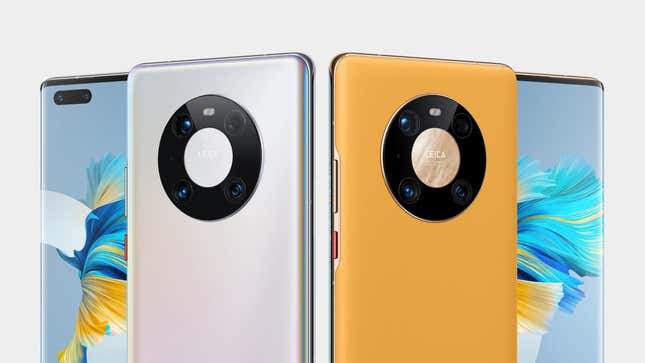
Right now it’s not a stretch to say that a lot of mainstream phones end up sporting very similar glass brick designs, but with Huawei’s new flagship phones—the Mate 40 and Mate 40 Pro—the company ditched the familiar camera bump for a head-turning “Space Ring.”
As you’d expect from a company that’s vying with Apple and Samsung for smartphone supremacy, the Mate 40 comes with a boatload of premium features including 3D face recognition, an in-display fingerprint sensor, a 6.76-inch 90Hz OLED display that wraps around the edges of the phone, and one of Huawei’s 5G-capable Kirin 9000 processors.

But the real eye-catching feature on the Mate 40 is clearly its Space Ring camera, which is not-so-subtly positioned around text letting you know Huawei’s cameras were created in partnership with Leica. On the Mate 40 and Mate 40 Pro, you get a total of three cameras including a 50-MP main cam with a large 1/1.28-inch sensor, a 20-MP Cinecam that uses an f/1.8 ultra-wide lens, and a telephoto camera (3x optical zoom on the Mate 40, 5x optical zoom on the MAte 40 Pro) along with a dedicated laser autofocus sensor.
All told it’s a pretty well-rounded setup, and between its design and Huawei boasting about additional camera features like the Mate 40's Steady Shot video stabilization, tracking autofocus, 3,840 fps slow-mo mode (at 720p), Huawei’s photo and video capabilities seem quite strong.

Elsewhere, Huawei says the Mate 40 can use its front-facing sensors and upgraded NPU for gesture recognition, allowing you flip through pages of an ebook by waving your hands up and down in front of the phone, or answering a call or controlling audio by simply hovering your hand in front of its screen. And if you want to silence the phone’s ringer, Huawei says you can do that by simply staring directly at the Mate 40.
These gesture controls seem a lot like what Google was exploring with Motion Sense on the Pixel 4, but expanded to even more apps and functions. So while Huawei still hasn’t reached the level of full sci-fi hand waving gesture controls, I’m kind of glad to see at least one company hasn’t given up on the idea yet.
One interesting note for the Mate 40 is that coming off the Mate 30 which featured a touch-sensitive volume rocker instead of physical buttons, it seems Huawei has come to its senses and reverted back to an old-school tactile volume rocker on the Mate 40 line.

In case all those features weren’t enough, today Huawei introduced two even fancier members of the Mate 40 family in the Mate 40 Pro+ which gets a longer 10x optical zoom and a bonus mid-range zoom cam with a 3x zoom, and the ultra-premium Porsche Design Mate 40 RS. Instead of a Space Ring camera, the Mate 40 RS features a huge octagonal camera bump, a ceramic back, and a vertical racing stripe to make sure you definitely don’t confuse it with its less expensive siblings. And with 12GB of RAM and 512GB of base storage, the Mate 40 RS is also by far the most expensive Mate 40.
The standard Mate 40 starts at 900 euros (around $1,060), with the Mate 40 Pro going 1,200 euros (around $1,400), before jumping up to $1,400 (around $1,650) for the Mate 40 Pro+ and maxing out at an eye watering 2,300 euros (around $2,700) for the Mate 40 RS.

Unfortunately, because Huawei still isn’t allowed to integrate Google Mobile Services or the Play Store into its phone, support for a lot of common apps and features (at least in the west) still aren’t available, which makes Huawei’s latest flagship sort of a non-starter for people in the U.S. That said, if you are willing to forgo Google services, Huawei has introduced a number of new first-party apps designed to replace popular Google apps such as Petal Search, Petal Maps, and Huawei Docs to help fill the gap left by the lack of Google apps. It’s not a total fix, but it’s something.
The Mate 40 line isn’t expected to officially go on sale in the U.S., but it will be rolling out globally across Europe and Asia starting in mid-November.